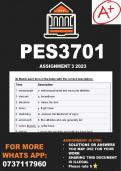,Question 1
Thank you for giving me the opportunity to share my high-level objectives for
developing a physical education program. As a physical educator, my primary
goal is to create a comprehensive and inclusive program that fosters the
overall well-being of students while instilling in them a lifelong love for
physical activity. Here are my key objectives:
1. Promoting Physical Health and Fitness: One of the core objectives of
any physical education program is to promote physical health and
fitness among students. I aim to design a curriculum that includes a
variety of activities, exercises, and sports to cater to the diverse needs
and interests of all students. By focusing on cardiovascular endurance,
strength, flexibility, and coordination, we can help students develop
healthy habits that will benefit them throughout their lives.
2. Fostering Motor Skills Development: For young learners, it is crucial
to focus on developing fundamental motor skills. I will implement age-
appropriate activities and exercises that target gross and fine motor
skills, helping students build a solid foundation for their physical
abilities.
3. Encouraging Sportsmanship and Teamwork: Physical education
provides an excellent platform to teach values like sportsmanship,
teamwork, and fair play. I will organize team-based activities and games
that emphasize collaboration, communication, and respect for others.
These qualities not only enhance their physical abilities but also
contribute to their social and emotional growth.
4. Adapting to Individual Needs: Every student is unique, and I
recognize the importance of catering to individual needs and abilities. I
will create an inclusive environment where students of all skill levels
and physical abilities can participate and feel supported. This might
involve modifying activities, providing adaptive equipment, or offering
alternative options.
5. Connecting with Other Subjects: Physical education should not be
isolated from other subjects; instead, it can complement and reinforce
academic learning. I will collaborate with other teachers and incorporate
interdisciplinary elements into the program, such as discussing the
science of exercise, the history of sports, or the cultural significance of
certain activities.
, 6. Promoting Lifelong Physical Activity: Beyond the school years, my
objective is to instill a passion for lifelong physical activity. By exposing
students to a wide range of activities and helping them find ones they
genuinely enjoy, I hope to motivate them to stay active and pursue
physical fitness beyond their time at school.
7. Monitoring and Assessing Progress: Regular assessment of
students' progress is vital for any effective physical education program.
I will implement various assessment methods to track their
development, including individual skill evaluations, fitness tests, and
self-assessments. This data will help me tailor the program to address
specific needs and ensure continuous improvement.
In conclusion, my high-level objectives for developing a physical education
program revolve around creating a well-rounded and inclusive experience
that not only focuses on physical health and fitness but also nurtures valuable
life skills. By promoting teamwork, adaptability, and a love for physical
activity, I aim to empower students to lead healthy, active, and fulfilling lives.
Question 2
Limited Sports Equipment and Facilities: The lack of funding and
resources may lead to a shortage of sports equipment and proper facilities,
hindering the variety and quality of physical activities that can be offered to
students.
1. Inadequate Professional Development Opportunities: Physical
educators in rural schools may face limited access to training and
professional development, making it challenging to stay updated with
the latest teaching techniques and best practices.
2. Transportation Barriers: Limited access to reliable transportation for
students can impact participation in extracurricular sports or off-site
physical activities, restricting their overall exposure to diverse physical
experiences.
3. Reduced Program Diversity: With limited resources, it may be difficult
to offer a wide range of sports and activities, potentially limiting
students' exposure to various physical pursuits.
4. Teacher Workload and Multitasking: Physical educators in rural
schools may have to handle multiple roles, such as coaching various
sports teams and managing administrative tasks, leading to increased
workload and potential burnout.




